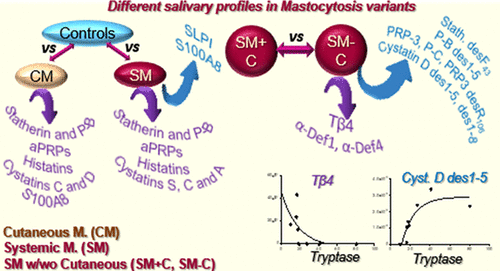当前位置:
X-MOL 学术
›
J. Proteome Res.
›
论文详情
Our official English website, www.x-mol.net, welcomes your
feedback! (Note: you will need to create a separate account there.)
Top-Down Proteomics of Human Saliva Discloses Significant Variations of the Protein Profile in Patients with Mastocytosis.
Journal of Proteome Research ( IF 3.8 ) Pub Date : 2020-06-24 , DOI: 10.1021/acs.jproteome.0c00207 Simone Serrao 1 , Davide Firinu 2 , Alessandra Olianas 1 , Margherita Deidda 2 , Cristina Contini 1 , Federica Iavarone 3, 4 , M Teresa Sanna 1 , Mozhgan Boroumand 5 , Francisco Amado 6 , Massimo Castagnola 5 , Irene Messana 7 , Stefano Del Giacco 2 , Barbara Manconi 1 , Tiziana Cabras 1
Journal of Proteome Research ( IF 3.8 ) Pub Date : 2020-06-24 , DOI: 10.1021/acs.jproteome.0c00207 Simone Serrao 1 , Davide Firinu 2 , Alessandra Olianas 1 , Margherita Deidda 2 , Cristina Contini 1 , Federica Iavarone 3, 4 , M Teresa Sanna 1 , Mozhgan Boroumand 5 , Francisco Amado 6 , Massimo Castagnola 5 , Irene Messana 7 , Stefano Del Giacco 2 , Barbara Manconi 1 , Tiziana Cabras 1
Affiliation

|
Mastocytosis is a myeloproliferative neoplasm causing abnormal clonal mast cell accumulation in different tissues, such as skin and bone marrow. A cutaneous subtype (CM) is distinguished from a systemic one (SM); SM patients can be grouped into SM with (SM+C) or without (SM-C) additional cutaneous lesions, and their classification is often challenging. This study was purposed to highlight variations in the salivary proteome of patients with different mastocytosis subtypes and compared to healthy controls. A top-down proteomics approach coupled to a label-free quantitation revealed salivary profiles in patients different from those of controls and a down-regulation of peptides/proteins involved in the mouth homeostasis and defense, such as statherin, histatins, and acidic proline-rich proteins (aPRPs), and in innate immunity and inflammation, such as the cathepsin inhibitors, suggesting a systemic condition associated with an exacerbated inflammatory state. The up-regulation of antileukoproteinase and S100A8 suggested a protective role against the disease status. The two SM forms were distinguished by the lower levels of truncated forms of aPRPs, statherin, P-B peptide, and cystatin D and the higher levels of thymosin β4 and α-defensins 1 and 4 in SM-C patients with respect to SM+C. Data are available via ProteomeXchange with identifier PXD017759.
中文翻译:

人类唾液的自上而下的蛋白质组学揭示了肥大细胞增多症患者蛋白质谱的显着变化。
肥大细胞增多症是一种骨髓增生性肿瘤,会在皮肤和骨髓等不同组织中引起异常的克隆性肥大细胞积聚。皮肤亚型(CM)与全身性亚型(SM)不同;SM患者可分为(SM + C)或无(SM-C)附加皮肤病变的SM患者,其分类通常具有挑战性。这项研究旨在强调具有不同肥大细胞增多症亚型的患者唾液蛋白质组的差异,并与健康对照进行比较。自上而下的蛋白质组学方法与无标记的定量相结合,揭示了患者的唾液曲线与对照组不同,并且口腔稳态和防御中涉及的肽/蛋白质(例如,抗凝素,组蛋白和酸性脯氨酸)的下调。富含蛋白质(aPRP),以及先天免疫和炎症,例如组织蛋白酶抑制剂,提示与炎症状态加重有关的全身性疾病。抗白蛋白和S100A8的上调提示对疾病状态有保护作用。与SM + C相比,SM-C患者中aPRP的截短形式,statherin,PB肽和cystatin D的水平较低,胸腺素β4和α-防御素1和4的水平较高,这两种SM形式的区别在于。数据可通过ProteomeXchange获得,其标识符为PXD017759。与SM + C相比,SM-C患者的血浆胱抑素D和胸腺素β4,α-防御素1和4的水平更高。数据可通过ProteomeXchange获得,其标识符为PXD017759。与SM + C相比,SM-C患者的血浆胱抑素D和胸腺素β4,α-防御素1和4的水平更高。数据可通过ProteomeXchange获得,其标识符为PXD017759。
更新日期:2020-08-08
中文翻译:

人类唾液的自上而下的蛋白质组学揭示了肥大细胞增多症患者蛋白质谱的显着变化。
肥大细胞增多症是一种骨髓增生性肿瘤,会在皮肤和骨髓等不同组织中引起异常的克隆性肥大细胞积聚。皮肤亚型(CM)与全身性亚型(SM)不同;SM患者可分为(SM + C)或无(SM-C)附加皮肤病变的SM患者,其分类通常具有挑战性。这项研究旨在强调具有不同肥大细胞增多症亚型的患者唾液蛋白质组的差异,并与健康对照进行比较。自上而下的蛋白质组学方法与无标记的定量相结合,揭示了患者的唾液曲线与对照组不同,并且口腔稳态和防御中涉及的肽/蛋白质(例如,抗凝素,组蛋白和酸性脯氨酸)的下调。富含蛋白质(aPRP),以及先天免疫和炎症,例如组织蛋白酶抑制剂,提示与炎症状态加重有关的全身性疾病。抗白蛋白和S100A8的上调提示对疾病状态有保护作用。与SM + C相比,SM-C患者中aPRP的截短形式,statherin,PB肽和cystatin D的水平较低,胸腺素β4和α-防御素1和4的水平较高,这两种SM形式的区别在于。数据可通过ProteomeXchange获得,其标识符为PXD017759。与SM + C相比,SM-C患者的血浆胱抑素D和胸腺素β4,α-防御素1和4的水平更高。数据可通过ProteomeXchange获得,其标识符为PXD017759。与SM + C相比,SM-C患者的血浆胱抑素D和胸腺素β4,α-防御素1和4的水平更高。数据可通过ProteomeXchange获得,其标识符为PXD017759。











































 京公网安备 11010802027423号
京公网安备 11010802027423号